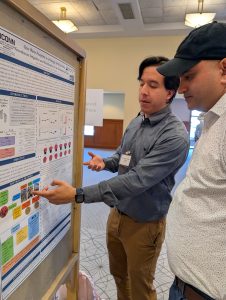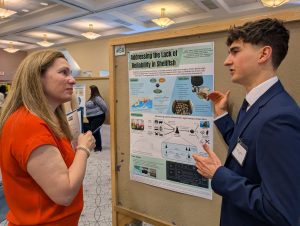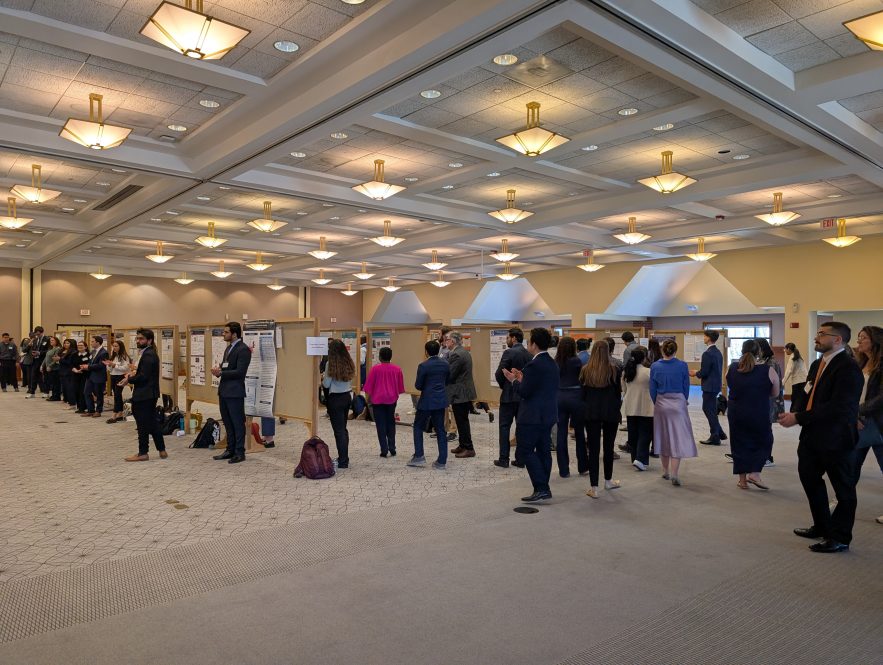For the first time at UConn, graduate students across all seven campuses had the opportunity to present their work at a single event: the Graduate Student Research Symposium.
Much of UConn’s graduate students’ research addresses real-world issues, allowing this inaugural symposium to not only celebrate academic excellence, but to also spotlight the impact graduate research has on Connecticut and beyond.
“Graduate students are having such a large impact on our community and on our state,” said Joy A. Hamer ’25 JD, the chief organizer of the symposium. “It was my mission to unite all seven of UConn’s branch campuses and showcase the hard work of our students.”
Hamer, who serves as the graduate student trustee on the UConn Board of Trustees, started envisioning the event that ultimately became the poster competition while campaigning for her trustee position. A key part of her campaign was going to all of UConn’s campuses and meeting with graduate students to hear about their experiences and find ways to help them succeed.
“Ultimately, what I found is most graduate students—irrespective of location or field of study—are conducting research that is very much interdisciplinary. For example, students studying pharmacy in Storrs, law in Hartford, or marine biology in Avery Point may all be focusing their research on environmental sustainability. Unfortunately, as we’re so dispersed across the state, a lot of our research becomes siloed,” said Hamer.

Hamer’s mission was to highlight not only the work of graduate students but also how their research benefits the places where they live and work, which culminated in the April 23 symposium held at Rome Commons Ballroom at UConn Storrs.
With scores of posters on display and hundreds in attendance, the symposium showcased the impressive breadth and depth of graduate research at UConn.
In the College of Agriculture, Health and Natural Resources’ Department of Plant Science and Landscape Architecture, Ph.D. candidate Alvaro Daniel Pantoja-Benavides presented his findings regarding the extent to which the Gray Water Footprint (GWF) – the volume of fresh water required to assimilate pollutants to meet water quality standards – can be used as an indicator to compare the environmental impacts of agricultural practices. His work provides insight into how irrigation and fertilizing strategies can be advanced while maintaining sustainable practices.
“This has given me great opportunities to show how research can impact the environment and agriculture,” said Pantoja-Benavides. “If we know how to utilizes strategies to practice agriculture better and teach people more about it, it will benefit so many.”
Each student who competed in the Symposium Poster Competition had their work categorized into one of six interdisciplinary research categories, with each category recognizing a winner and runner-up, followed by the winners competing in a final round. The overall winner and runner-up in the final round both came from the department of Molecular and Cellular Biology in the College of Liberal Arts and Sciences.
Ph.D. candidate Caroline Vieira da Silva won overall in the Cognition, Health, and Medicine category and then won the final round for her research titled, “Identification and characterization of the surface layer protein AvsA in outer membrane vesicles, antibiotic resistance, and in vivo host colonization in Aeromonas veronii.” Ph.D. candidate Sarah Pasqualetti came in first in the Economy, Energy, and Environment category, and was the overall runner-up for her work with microplastics.
One goal Hamer kept in mind while planning the poster competition was to give graduate students the opportunity to present their research to wider audiences, especially individuals who are not in their respective fields.
“Because we’re so dedicated to our research, as graduate students, it becomes easy to communicate exclusively in terms of art and industry jargon. This can make comprehension difficult for someone who isn’t in that discipline,” said Hamer. “So, the point is to be able to articulate and explain your research across sectors.
Although poster competitions are commonly found in STEM fields, said Hamer, they seem to be translatable across disciplines. “As a law student, I’ve primarily participated in Moot Court, Mock Trial, and Negotiation competitions—all of which are very industry-specific.” Hosting this event as a poster competition offers graduate students of any field the chance to participate in sharing their findings. Additional formats such as pitch competitions and video competitions are in the works for the future iterations of the symposium.
“It’s been helpful to learn how to communicate my research with different audiences,” said Muireann Nic Corcráin, a Ph.D. candidate in Applied Linguistics and Discourse Studies. “Talking to departments who aren’t in my field and don’t initially understand my work can further show the importance of cultural revival.”

In her research titled, “I Have a Voice: Towards the Development of Synthetic Voices for the Passamaquoddy Language,” Corcráin focused on the language revitalization of the Passamaquoddy language.
This Native American language is only spoken by 12% of 3,600 members, according to Corcráin’s research, which motivated her to work towards developing a text-to-speech synthetic voice for the language.
Her commitment to language revitalization and developing resources for ancestral languages, like the Passamaquoddy language, led her work to be recognized as the runner-up in the Humanity, Culture, and Arts category of the competition.
“It’s nice to be able to research something that has an impact on so many people, and that UConn provides us with these resources to do so,” said Julia Jerolamon, a Ph.D. student in the department of Molecular and Cellular Biology. Her research focuses on deactivating a protein that, when found in high levels, has been shown to reduce survivability rates among patients with cancer.
Hamer, who worked closely with Leslie Shor, Vice Provost for Graduate Education and Dean of The Graduate School, on organizing the event, said she was thrilled with the successful debut of what she expects to become a regular event for UConn graduate students.
“This was our very first year, and I am so proud of our team and our engagement with the students. We’re looking forward to hosting this again in the future,” said Hamer.



